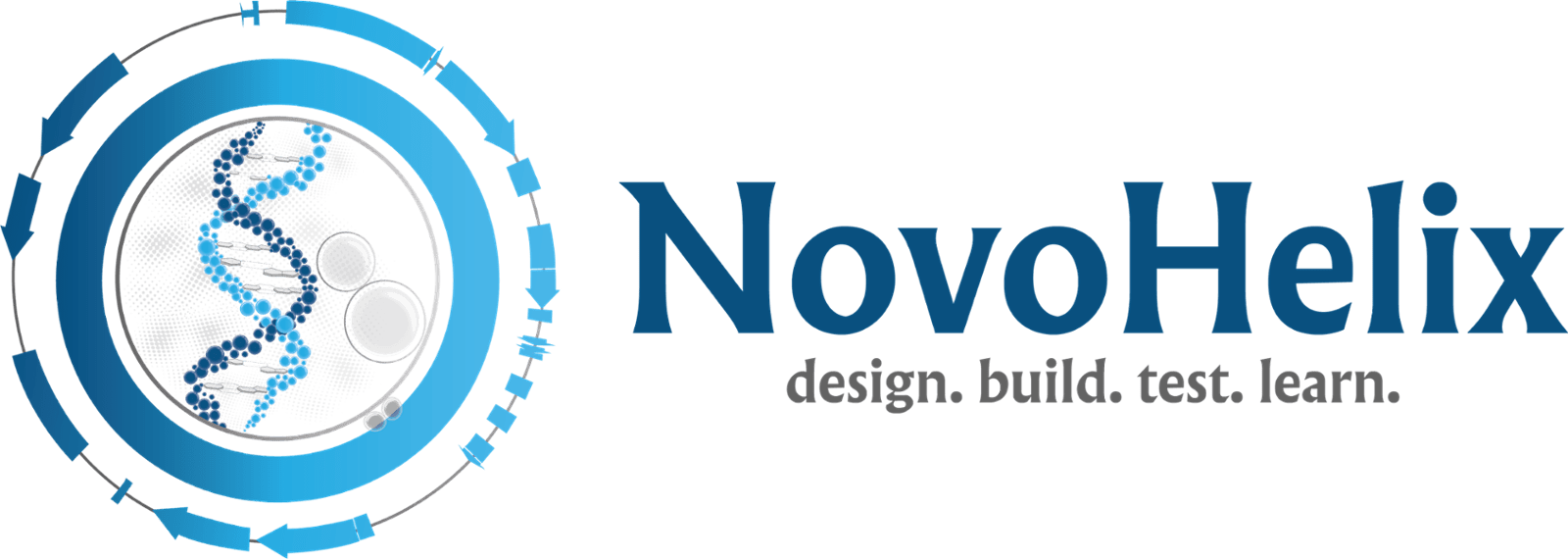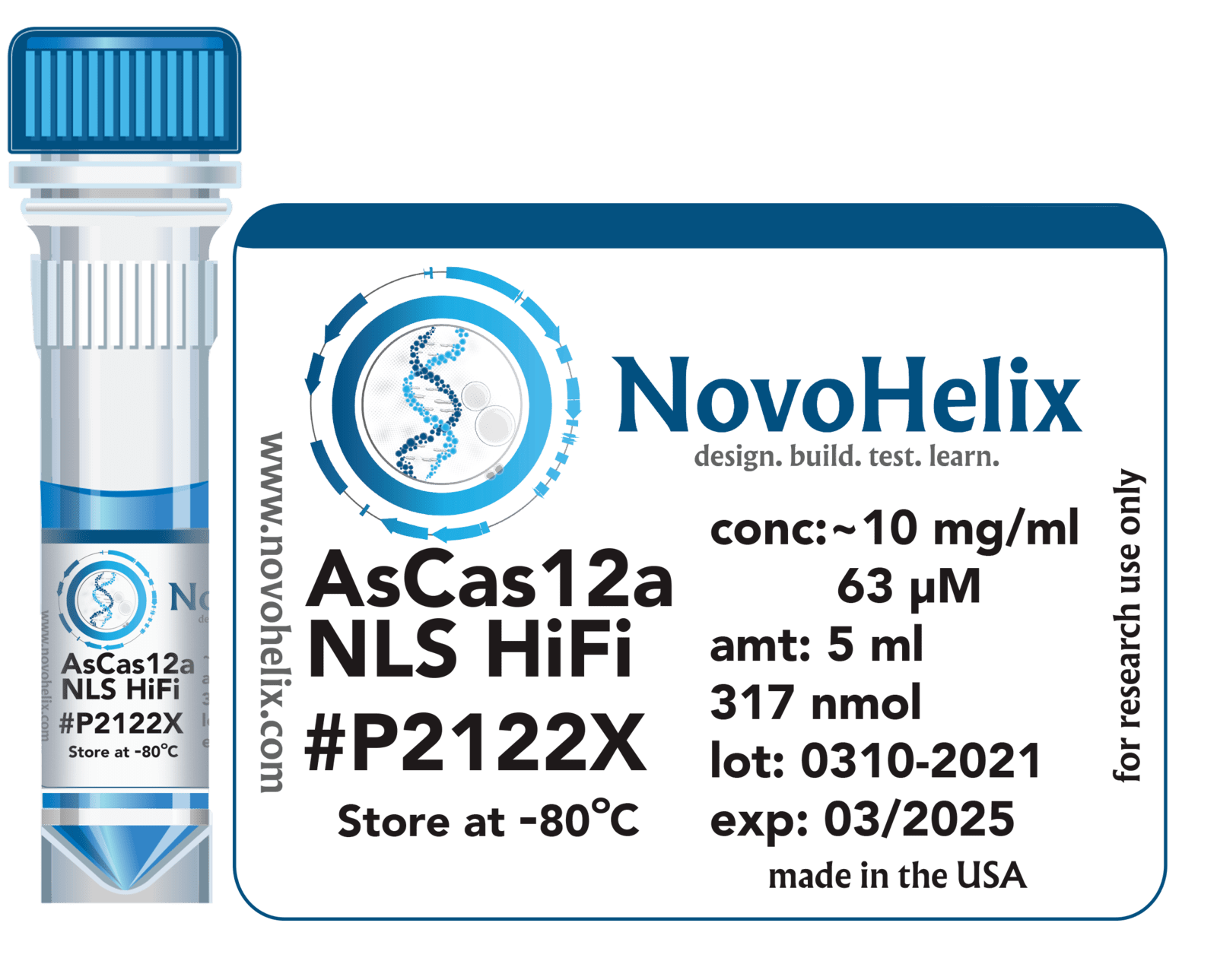AsCas12a NLS HiFi — Acidaminococcus sp. BV3L6 Cas12a
NovoHelix manufactures high-quality Cas editors for sensitive applications such as DNA-writing and DNA-editing of early mammalian embryos. During early developmental stages such as the one-cell zygote or two-cell blastomere, microinjection or electroporation is used to deliver Cas12a (also known as Cpf1) as ribonucleoprotein (RNPs) complexes to introduce germline genetic modifications for generation of biomedical animal models. Each lot of NovoHelix’s AsCas12a NLS HiFi is functionally tested in mouse zygotes by knock-in of a fluorescent reporter at the Rosa26 safe harbor locus. AsCas12a NLS HiFi contains bipartite nuclear localization sequence (NLS) on the N- and C- termini of the protein.
Product
Catalog Nr
Size
Concentration
Pricing
AsCas12a NLS HiFi
P2122B
bulk
Want to try this product? Request a sample of AsCas12a NLS HiFi.
Product Information
Product Literature & Protocol
FAQs & Troubleshooting
References
Supporting Documents
Product Information
Applications:
- Cas12a requires only crRNA to cleave making it easier to multiplex for digital genome editing
- 5’ overhanging termini after cleavage
- Functional knockout of primary cells and human pluripotent cell lines
- Precise genome editing by microinjection of preimplantation mammalian embryos
- RNP electroporation of cells and zygotes
- CRISPR editing of T-rich TTTV PAM sequences
Source:
AsCas12a NLS HiFi is a class 2, Cas type V endonuclease with RuvC-like domain. The AsCas12a NLS HiFi was improved through protein engineering efforts. The final engineered protein was synthesized as a codon-optimized minigene, was expressed heterologously in an E. coli strain with the assistance of chaperone proteins and was purified by proprietary chromatographic techniques. This product is manufactured in the USA using chemically-defined components and, therefore, does not contain manufacturing components such as serum or animal-derived raw materials. AsCas12a NLS HiFi is suitable for sensitive applications such as pronuclear zygotic microinjection of Cas9 ribonucleoprotein (RNP) complexes in mouse, rat, pig, cow and goat zygotes.
Molecular Weight:
~156 kDa
Purity:
>98 % by SDS-PAGE and analysis by protein mass spectrometry. The recombinant protein is free of residual chromosomal DNA from the expression chassis (E. coli strain B) as determined by a quantitative real-time PCR assay.
Sequence Analysis:
Purified recombinant protein was subjected to peptide mass fingerprinting (PMF) by MALDI-TOF/TOF (PMF + MS/MS).
10X AsCas12a NLS HiFi Reaction Buffer:
100 mM HEPES pH 6.5 @ 25°C1.5 M NaCl50 mM MgCl21 mM EDTA
Functional Testing:
Microinjection of mouse zygotes. The AsCas12a NLS HiFi endonuclease was tested for functional activity by direct microinjection of ribonucleoprotein complexes containing 400 nM AsCas12a NLS HiFi protein, 600 nM chemically-modified 5′ extended crRNA for Rosa26 and 20 ng/ul supercoiled donor vector Rosa26-H2b-mCherry into pronuclear stage zygotes. Mouse ∼E13.5 C57BL/6J embryos were collected and visualized for fluorescence of mCherry, and screened by long-range junction PCRs for knock-in at the safe harbor locus Rosa26. Additional PCR assays were designed to screen across the crRNA target site and these amplicons were submitted for Sanger sequencing to determine animals containing indel mutations. Survival rates of zygotes post-microinjection from mock injection controls and RNP injected zygotes were greater than 80% and 70% reached ~E13.5. Greater than 40% of surviving ~E13.5 embryos were modified by AsCas12a NLS HiFi endonuclease activity to pass lot functional testing criteria.
Slide electroporation of one-cell zygotes. To functionally test AsCas12a NLS HiFi gene editing activity in livestock embryos including pigs, cows and goats, diploid parthenotes were generated from abattoir-collected oocytes. AsCas12a NLS HiFi protein, a fluorescent 5’-ATTO-labeled and chemically-modified 5′ extended crRNA for Rosa26 were electroporated using a square wave pulse generator in a microscopic glass slide format containing 50 zygotic parthenotes placed in a line between the 1 mm electrode gap. Parthenotes were recovered after overnight culture, and individual embryos were lysed for whole genome amplification (WGA). Genotyping of WGA material from individual parthenotes was performed by a PCR assay that spans the Rosa26 target site. Amplicons were submitted for Sanger sequencing. Greater than 40% of surviving parthenotes were modified by AsCas12a NLS HiFi endonuclease activity to pass lot functional testing criteria. Survival rates of parthenotes after slide electroporation from mock (AsCas12a NLS HiFi only, no crRNA) controls and experimental group with AsCas12a RNP complexes were greater than 90%.
Residual Nuclease Activity:
AsCas12a NLS HiFi is free from detectable RNase A, endonuclease (nicking) and non-specific DNase activities as determined by fluorometric assays using cleavable fluorescent-labeled substrates to be less than the limit of quantitation ≤ 0.3 pg/ml.
Endotoxin:
Lipopolysaccharide (LPS) was determined by the standard LAL (Limulus amebocyte lysate) test to be < 0.5 EU/µg. Due to potential environmental sustainability concerns (collection of the hemolymph used in pharmaceutical testing may negatively affect horseshoe crab populations), a quantitative and more sensitive endotoxin assay was developed using a pyrogen‐testing cell model with knock-in (targeted, single-copy integration) of TLR4/CD14/MD2 at the safe harbor locus AAVS1/PPP1R12C on human chromosome 19. The TLR4/CD14/MD2 assay is used as an orthogonal screen for LPS in lieu of the LAL method and has a detection limit of 0.005 EU/ml.
Appearance:
A sterile, aqueous, clear and colorless solution.
Formulation:
AsCas12a NLS HiFi is supplied reconstituted at 10 mg/ml in a stabilization buffer containing 50 mM HEPES, 300 mM NaCl, 0.1 mM EDTA, 0.1 mM TCEP, 0.01% Tween-20, 50% (v/v) glycerol at a pH ~6.0. The reconstituted solution has been filter sterilized by passing through a 0.22 micron PES membrane and tested to be negative for mycoplasma contamination.
Storage/Stability:
AsCas12a NLS HiFi is supplied at 10 mg/ml in stabilization buffer. Stock solutions of AsCas12a NLS HiFi in its concentrated form can be stored at least 6 months at -20°C and at least 12 months at -80°C from the date of manufacture with no loss of activity. For long term storage, add 0.1% w/v carrier protein such as recombinant human serum albumin (HSA) and avoid repeated freeze-thaw cycles by aliquoting. Multiple freeze-thaw cycles reduce potency and, therefore, aliquoting working stocks is strongly recommended. To maximize recovery, spin the microcentrifuge tube prior to opening but do not vortex. For genome editing experiments such as preparation before microinjection of zygotes, prepare an RNase-free work area using only RNase-free reagents and consumables such as microcentrifuge tubes, and barrier pipette tips while setting up these experiments.
Disclaimer & Precautions:
This product is solely for research and development use only and may be subject to conditional use and licensing restrictions. The product shall not be used as an advanced pharmaceutical intermediate (API) or investigational drug or a biologic. This product is not intended to be used as a therapeutic agent or facilitate clinical diagnosis or be used as an in vitro diagnostic (IVD) product.
The Food and Drug Administration (FDA) and Center for Biologics Evaluation and Research (CBER) define an IVD as:
“In vitro diagnostic products are those reagents, instruments, and systems intended for use in the diagnosis of disease or other conditions, including a determination of the state of health, in order to cure, mitigate, treat, or prevent disease or its sequelae. Such products are intended for use in the collection, preparation, and examination of specimens taken from the human body. These products are devices as defined in section 201(h)of the Federal Food, Drug, and Cosmetic Act (the act), and may also be biological products subject to section 351 of the Public Health Service Act. Title 21, Code of Federal Regulations (CFR), section 809.3(a).”
This product shall not be used or formulated in any agricultural, pesticidal, veterinary or animal products, food additives or household chemicals or any other unspecified use. Please consult the Safety Data Sheet for information regarding hazards and safe handling practices. NovoHelix distributes products for basic and translational research use only. NovoHelix will report any unspecified use to respective regulatory authorities for enforcement to ensure safeguarding of our research products from potential abuse.
Notice to purchaser:
The purchase price of this product includes a limited, non-transferable license under U.S. and foreign patents or applications owned by NovoHelix to use this product. No other license under these patents or applications is conveyed expressly or by implication by purchase of this product.
Product Literature & Protocol
- HiFi DNA Assembly Protocol
Recommended Amount of Fragments Used for Assembly
| 2–3 Fragment Assembly* | 4–6 Fragment Assembly** | Positive Control✝ | |
| Recommended DNA Molar Ratio | vector:insert = 1:2 | vector:insert = 1:1 | |
| Total Amount of Fragments | 0.03–0.2 pmols* X μl | 0.2–0.5 pmols** X μl | 10 μl |
NovoHelix HiFi DNA Assembly Master Mix | 10 μl | 10 μl | 10 μl |
| Deionized H2O | 10-X μl | 10-X μl | 0 |
| Total Volume | 20 μl✝✝ | 20 μl✝✝ | 20 μl |
* Optimized cloning efficiency is 50–100 ng of vector with 2-fold excess of inserts.
Use 5 times more insert if size is less than 200 bp. Total volume of unpurified PCR fragments in the assembly reaction should not exceed 20%.
**To achieve optimal assembly efficiency, design ≥ 20 bp overlap regions between each fragment with equimolarity (suggested: 0.05 pmol each).
† Control reagents are provided for 5 experiments.
†† If greater numbers of fragments are assembled, increase the volume of the reaction linearly by using additional NovoHelix HiFi DNA Assembly Master Mix. Alternatively, pool the DNA fragments into an equimolar mix first and then re-purify these pooled equimolar fragments over a micro-column and elute with a minimum volume (~10-µl). The eluate may be reapplied to the same micro-column membrane to improve elution of large DNA fragments without increasing the final volume..
Recommended Storage Condition:
This assembly mixture can be stored at -20 °C for at least one year. The enzymes remain active following at least 10 freeze-thaw cycles.
FAQs & Troubleshooting
References
1: Takahashi K, Tanabe K, Ohnuki M, Narita M, Ichisaka T, Tomoda K, Yamanaka S. Induction of pluripotent stem cells from adult human fibroblasts by defined factors. Cell. 2007 Nov 30;131(5):861-72. PubMed PMID: 18035408.
1: Marinho PA, Chailangkarn T, Muotri AR. Systematic optimization of human pluripotent stem cells media using Design of Experiments. Sci Rep. 2015 May 5;5:9834. doi: 10.1038/srep09834. PubMed PMID: 25940691; PubMed Central PMCID: PMC4419516.
1: Kuo HH, Gao X, DeKeyser JM, Fetterman KA, Pinheiro EA, Weddle CJ, Fonoudi H, Orman MV, Romero-Tejeda M, Jouni M, Blancard M, Magdy T, Epting CL, George AL Jr, Burridge PW. Negligible-Cost and Weekend-Free Chemically Defined Human iPSC Culture. Stem Cell Reports. 2020 Jan 9. pii: S2213-6711(19)30446-1. doi: 10.1016/j.stemcr.2019.12.007. [Epub ahead of print] PubMed PMID: 31928950.
1: Ludwig TE, Bergendahl V, Levenstein ME, Yu J, Probasco MD, Thomson JA. Feeder-independent culture of human embryonic stem cells. Nat Methods. 2006 Aug;3(8):637-46. Erratum in: Nat Methods. 2006 Oct;3(10):867. PubMed PMID: 16862139.
1: Ludwig T, A Thomson J. Defined, feeder-independent medium for human embryonic stem cell culture. Curr Protoc Stem Cell Biol. 2007 Sep;Chapter 1:Unit 1C.2. doi: 10.1002/9780470151808.sc01c02s2. PubMed PMID: 18785163.
1: Chen G, Gulbranson DR, Hou Z, Bolin JM, Ruotti V, Probasco MD, Smuga-Otto K, Howden SE, Diol NR, Propson NE, Wagner R, Lee GO, Antosiewicz-Bourget J, Teng JM, Thomson JA. Chemically defined conditions for human iPSC derivation and culture. Nat Methods. 2011 May;8(5):424-9. doi: 10.1038/nmeth.1593. Epub 2011 Apr 10. PubMed PMID: 21478862; PubMed Central PMCID: PMC3084903.
1: International Stem Cell Initiative Consortium, Akopian V, Andrews PW, Beil S, Benvenisty N, Brehm J, Christie M, Ford A, Fox V, Gokhale PJ, Healy L, Holm F, Hovatta O, Knowles BB, Ludwig TE, McKay RD, Miyazaki T, Nakatsuji N, Oh SK, Pera MF, Rossant J, Stacey GN, Suemori H. Comparison of defined culture systems for feeder cell free propagation of human embryonic stem cells. In Vitro Cell Dev Biol Anim. 2010 Apr;46(3-4):247-58. doi: 10.1007/s11626-010-9297-z. Epub 2010 Feb 26. PubMed PMID: 20186512; PubMed Central PMCID: PMC2855804.
1: Yasuda SY, Ikeda T, Shahsavarani H, Yoshida N, Nayer B, Hino M, Vartak-Sharma N, Suemori H, Hasegawa K. Chemically defined and growth-factor-free culture system for the expansion and derivation of human pluripotent stem cells. Nat Biomed Eng. 2018 Mar;2(3):173-182. doi: 10.1038/s41551-018-0200-7. Epub 2018 Mar 5. PubMed PMID: 31015717.
1: Zhou M, Shi W, Yu F, Zhang Y, Yu B, Tang J, Yang Y, Huang Y, Xiang Q, Zhang Q, Yao Z, Su Z. Pilot-scale expression, purification, and bioactivity of recombinant human TGF-β(3) from Escherichia coli. Eur J Pharm Sci. 2019 Jan 15;127:225-232. doi: 10.1016/j.ejps.2018.11.009. Epub 2018 Nov 10. PubMed PMID: 30423434.
1: Luo Z, Jiang L, Xu Y, Li H, Xu W, Wu S, Wang Y, Tang Z, Lv Y, Yang L. Mechano growth factor (MGF) and transforming growth factor (TGF)-β3 functionalized silk scaffolds enhance articular hyaline cartilage regeneration in rabbit model. Biomaterials. 2015 Jun;52:463-75. doi: 10.1016/j.biomaterials.2015.01.001. Epub 2015 Mar 18. PubMed PMID: 25818452.
Supporting Documents


